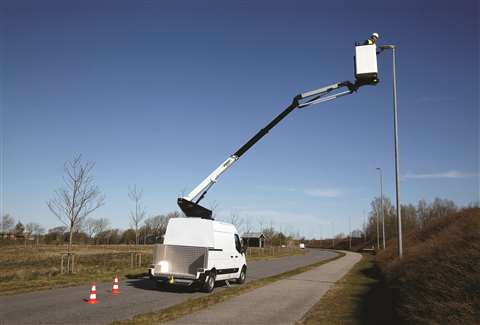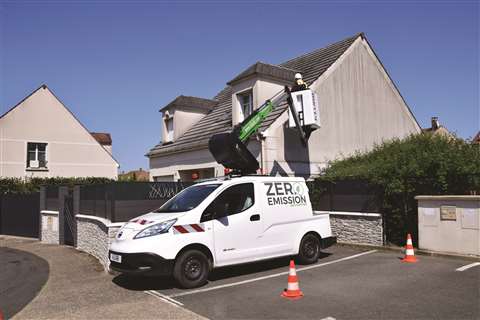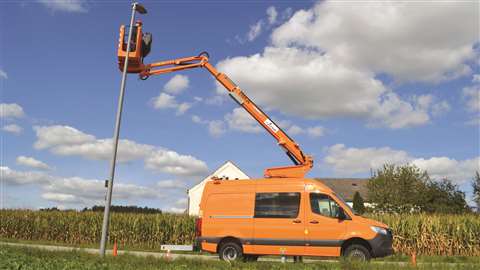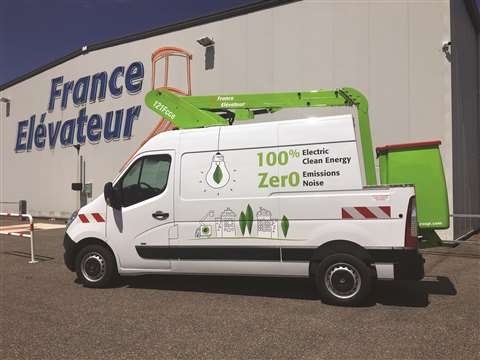Van mounted platforms
20 October 2020
A mainstay of the access platform industry, the van mount is also leading the way in the design of compact lifts that are increasingly 100% electric, or hybrid, for city working, and offer greater payload within the confines of the chassis - often required to be a maximum of 3.5 tonnes for use with a Category B standard EU driving licence. The product type has also been less affected by Covid-19 than other product types, as much of its work falls within essential maintenance and local government contracts.
Versalift has launched the latest model in the VTL range of platforms. The 15.1m working height double telescopic VDTL-150-F delivers unrivalled performance, said the company, with twin telescopic sections, allowing it to be installed on a compact 3.5 tonne Renault Master cut away van. The model offers an outreach of 7.7m, at a safe working load of 120kg, and a total length of 5.9m.

Versalift’s 15.1m working height double telescopic VDTL-150-F.
First launched in 2018, the VTL range’s design, strength and safety features have reshaped van mounted platforms, said the manufacturer. The profiled booms are strong and light, and at 350kg, after driver, passenger and a full tank of fuel, the VDTL-150-F offers the possibility to fit bespoke racking for carrying additional tools and spare parts.
The cut away van has had great success in France, added Versalift, with interest now growing across Europe. Its compact dimensions behind the rear axle, make it ideal for inner city streetlight maintenance. The platform is designed, manufactured and produced in Europe and designed to meet the requirements of the European market.
Versalift has also been moving further into electric-powered lifts. Its VTL-120 and VTL-135-F, mounted on a Renault Master ZE full electric vehicle, were launched at Bauma 2019. A bit later that year the VTL-135-F version was ready and waiting to be exhibited at APEX 2020, together with the launch of the Versalift plug in hybrid solution, mounted on a Fiat Doblo, before the show was postponed.
Power solutions
The main feature of the full electric models is that both vehicle and platform run on electric power. With the hybrid solution, just the platform runs on electric power
The Danish company will continue to develop the technology and is awaiting development of the appropriate vehicles, for example the Renault ZE, with greater drive range and an upgrade to 3.5 tonne GVW. “We’ll keep on monitoring the market for manufacturing of full electric vehicles, among others the MB, and we’ll mount on selected models,” says Martin Sloth, director of sales, Europe.
Versalift’s first full electric access platform vehicle was launched back in 2009, but at that time the market was not ready for 100% electric options, says Sloth. In the meantime, the company has developed power packs for 99% of the units it produces, from 9m working height, mounted on the tiny Fiat Doblo, to the high voltage insulated platforms, mounted on 18 tonne trucks.
The company offers lithium-ion, depending on the weight and capacity of the model and uses lead acid and GEL, due to their lower cost. “When and if the price of lithium-ion becomes cheaper, it will replace lead acid and GEL.”
In a bid to develop full electric solutions, Versalift has set up the Aerial Device and Electrical Vehicle Association (ADEVA). The purpose of this European network is to enhance knowledge of full electric and hybrid solutions for aerial devices. All the members have an interest in and plans for expanding their fleet with full electric and or hybrid products.
Over the last two years France-based Klubb has been developing very compact models which are cost effective and designed to work quickly in cities. In addition, the company has been working on electric models.
The manufacturer currently has a wide range of van mounts from the 10m lift on mini van to a 15m working height platform on a standard van. These cover the mini-van segment, including the Renault Kangoo, medium-sized lifts on a Peugeot Expert and the 3.5 tonne segment with lifts mounted on Renault Master and Mercedes Sprinter, among others. Sales are now split equally between them.
Regarding electric models, the best seller is the K20 on a cutaway eNV200, with 10m working height and 5m outreach, and no outriggers. This conversion has a 10m working height and a one man basket. One of the main advantages of the K20 is a range of 200km on the road, says the company.
Compact requirements
Another model for narrow or pedestrian access is the K20 mounted on a Goupil G4 van. It is distinguished by its ability to work in exceedingly small spaces thanks to a vehicle width of 1.5m.

Regarding hybrid models, Klubb’s Green Pack is an option for all units in the company’s range. This allows the boom to be operated using battery power with the engine switched off. So far, the company has even equipped its 25m working height Xtenso5 model with the pack, mounted on a heavy truck.
Another hybrid option from the company is the K38P, on a 3.5 tonne Renault Master, with the green pack option and offering a working height of 13.8m and lateral outreach of 8.20m, with one operator, plus a jib.
The company will next launch a light range of van mounts with 140kg of additional payload. This weight gain has been achieved in particular thanks to a new design of the boom, made from High Elastic Limit Steel (HLE). “These so-called high performance steels make it possible to lighten the structure and increase the resistance as well as the service life of the equipment,” says Klubb.
A new KL32, on a Renault Master was presented this month at the JDL Expo. It is emblematic of the KL range, says the manufacturer, and has been designed with optimum payload in mind, on a 3.5 tonne vehicle. “Our objective is to provide our customers with the best solutions to their current challenges, which includes the best local service everywhere that a Klubb machine is sold. We are building an extensive network of Klubb dealers who all offer outstanding levels of service,” explained the company.
On this subject, exports are another strategic development for Klubb, “We are structuring ourselves according to the growth of our distributors around the world. Today we have a team of around 15 people 100% dedicated to international development.
“Based on our experience as a distributor, we know there is a need to adapt to the needs of end users who work differently in each country. We therefore work in close collaboration with our distributors in order to understand the specificities of their country and to respond to their requests - new options, technical training, assembly assistance, etc.”
The new Worldwide Harmonised Light Vehicle Test Procedure (WLTP) standards are changing the market, as CO2 targets are becoming more important for the economic performance of vehicle manufacturers all over the world, explains Klubb, therefore green energies will become key challenges for the sector.
“By default, we are oriented towards hybrid given the low supply of electric vehicles for commercial use. However, we are at the forefront of the development of lifts on 100% electric vehicles and we are working in close collaboration with car manufacturers to design new models.”
On the subject of Covid-19, the company says it, “scrambles the cards when identifying growing markets,” adding, “We have very poor visibility on the delivery dates of vehicles from the car builders. This greatly complicates the management of schedules.”
Nevertheless, opportunities are arising. “In most of the countries in Europe van mounts are a pretty mature market segment; the growth is quite steady. Nevertheless, there are a lot of opportunities in new markets in South America, for example. Given the fact that most of the countries were or are facing bans and border closures due to Covid-19, exporting becomes more complicated. There is still a long way to go until the whole industry is restored back to its full capacity.
Long distance
The most recent launches from GSR are two hybrid versions of existing models. The E140TJV and E170TJV, with 14m and 17m working height, respectively, offer a large payload and the option of driving using the combustion engine or battery power pack, separately.
The models can be mounted on up to 5 tonne vans and offer an effective residual payload of up to 1 tonne. Other features include a good speed, long operating autonomy and good residual flow rate, says the company, which is essential for the replacement of light bulbs in street lighting that requires a large number of daily work cycles.

Furthermore, with GSR’s rapid charging module, there is no need for sockets, columns, cables or long waiting periods. GSR also plans to create a fast-charging hybrid version of its 12.5m working height platform, again offering high residual loads of about 350kg, on 3.5 tonne GVW vehicles.
In the near future, we will see a range of GSR platforms made for the new 3.5 tonne mild‐hybrid vans, which only use their electric motors to support the engine during acceleration and cruising, and have just arrived on the market.
GSR says future developments in van mounts will be driven by green power solutions, meaning electric, hybrid or other options. “Another difference, that is becoming more evident, is the push of the market in two seemingly opposite directions: long lasting and durable machines with high level technological and innovative features, and short-lived machines, aimed at minimal investment and often with a life expectancy of the machine that is not very ambitious.”
The company explains that, compared to other types of aerial platform applications and construction activities, maintenance and public utility services are less affected by Covid‐19, which helps the van mounted sector. However, “The socio‐economic conditions of the various global markets make a difference and the variation between the north and south of the world is enormous,” says GSR.
In addition to this, clear differences also exist between countries in the same region; for example between countries of Northern Europe, compared to those of North America. “These differences highlight how there is a growing market but not a ‘global product’.
“Surely, we will have to develop these products in a more sustainable way. Covid‐19 is the manifestation of what will happen if we do not change direction, and make the priority a global one, above different technical requirements and local customs. I do not think that low cost will be compatible with the needs of improving the environmental footprint.”

Comet’s latest launch is the new Eurosfilo Jib Van, with 12m and 14m working height options, mounted on classic van models. A difference with Comet’s products is that there is no column inside the van, therefore users can load goods inside without obstruction.
The second new series in the range is the Street Lighter. Demonstrations of the new model were made in the UK in February 2020, before the Covid-19 lockdown.
The Street lighter is the evolution of the manufacturer’s X Van and has a new aluminium basket, with two doors. The philosophy behind the Street Lighter is a vehicle for the transport of materials and people, thanks to a large inside area, without being overweight. The model is very light and suitable for electrical, telephone line and other utility applications. Two versions, 12m and 14m working heights, are available, both with insulated baskets to 5 kV with a capacity of 200kg. They can be mounted on the full range of vans, including Iveco Daily and Ford Transit.
The company was the first to introduce a 100% insulated machine to 46 kV, equipped with a fiberglass ended boom. Comet is now developing other insulated models on vans, with the main focus being lightness. More information about these products will follow as it is available.
Comet also prides itself in its ability to offer lifts in kit form that are suited to different vans, wherever they are manufactured around the world. In 2015 the company sold around 300 vans in Iraq. “We sell in the Middle East and Asia. Our solution is very interesting because it is easy to install in kit form without modifications to the vehicle.”
Growth spurt
The latest model From Movex is a 15.2m working height unit with fly jib, launched at the beginning of 2020. The company says it has already manufactured a ‘good number’ of units.

The main features are greater payload, combined with working height on a 3.5 tonne van. The model offers 8m outreach and precise joystick control. The company has a new model in design but no information is available yet.
The van mount market is in a growth spurt, according to the company, “The van market is growing every day, in our case, in 2020 we doubled van platform production.”
The most important requirement for customers is a comprehensive range of accessories and options, says Movex, including models with or without outriggers, hybrid versions, equipment installed in the vehicle, ladder support or a flashing beacon.

France Elévateur most recently introduced the ZE 100% electric 121 Fcce, on Renault Master, with 12m of working height and 7m outreach. The range of the van is 120km on a single charge and 25 work cycles for the platform, corresponding to two working days.
In October this year, the company will launch the new 101 Fcc, mounted on a Renault Trafic L2H1, offering 10m working height and 6.2m outreach. The model is very compact and has 480kg of payload, among other innovations.
The main trends in the sector, says the company, is the compact cut away on 3.5 tonne vehicle, with more payload. This is combined with the move to 100% electric vehicles.
Despite the Covid-19 pandemic and a factory closure of one month, during the lockdown in France, the company has opened a new production line dedicated to 12m working height platforms.
The workshop has the capacity to produce three machines per day. “We are a sector little affected by Covid-19.”






